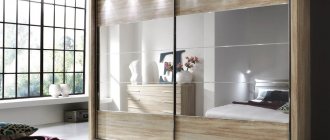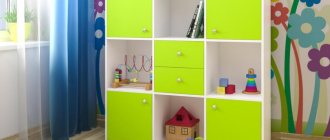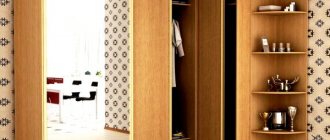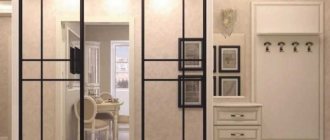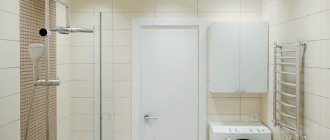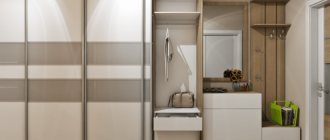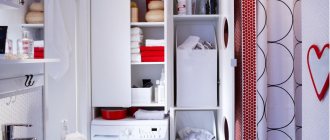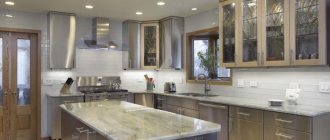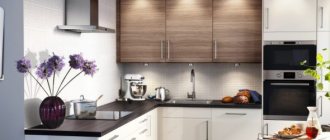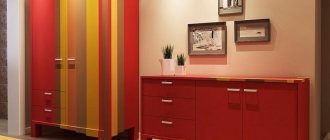Design Features
Household appliances hidden in pieces of furniture are a characteristic feature of modern design. Installing a special cabinet for a washing machine, or, as an option, installing the unit in a finished structure, allows you to optimize the situation in the bathroom or kitchen.
Sometimes structural niches in non-standard rooms are used to accommodate a washing machine.
Advantages of built-in technology:
- various devices that ensure the operation of the machine connected to utilities are hidden behind the walls;
- the vertical space above the washing machine is used to store many useful things;
- Compact installation of the machine allows you to free up space;
- the internal content of the module ensures order in the room and eliminates clutter with unnecessary objects;
- the cabinet plays the role of a soundproof barrier - it significantly absorbs noise and vibration when the machine operates on the spin option;
- walls and doors protect the technical device from high humidity and inevitable corrosion of the housing.
A design feature is the need for ventilation so that odors do not accumulate inside the washing machine and high humidity does not arise. Preventative inspection of the device after operation is mandatory to prevent leaks. Conventional design disadvantages are not as significant as the advantages of rational placement of the machine. The original design of the module with a cabinet ennobles the room; the doors hide equipment, which in its purpose is connected with the utility area, not the guest area. Less dust accumulates in the closed compartment, and the freed floor is easier to wash and keep clean.
The vertical space above the machine can be used for storing things
The cabinet acts as a soundproof barrier
Compact installation of the machine allows you to free up space
Facade design options
The front part of the cabinets can be completely or partially closed, or completely open (for example, in open shelving). The latter option is inexpensive, and in general, such a cabinet performs its functions. But all things will be in plain sight, and in order for the room to look neat, you will have to constantly maintain perfect order. In addition, open shelves get dirty much faster.
Partially open washing machine cabinets are most common. Usually the section for the washing machine is left open. It is also advisable to leave one or two shelves for frequently used items (so as not to open and close the cabinet dozens of times a day). If there is space, models with closed fronts are sometimes complemented with open side shelves. Combined cabinets are made partially open - for example, a closed pencil case and an open shelving unit or a chest of drawers with open shelves and a countertop for a washbasin.
Facades that completely cover appliances and storage systems are chosen for built-in wardrobes or in cases where you simply want to hide all the objects that distract attention from the interior.
Classification
The multifunctional design of a washing machine cabinet comes in different types. The features of the built-in module are determined by the availability of free space, the dimensions of the device, and the interior of the room. The basis for choosing a design is:
- Ready-made models from built-in equipment sales centers.
- Custom-made cabinets, the parameters of which take into account the needs of the client.
Classification of shelving cabinets, functional design features
Equipment in the cabinet is placed from the standpoint of practicality, aesthetic appeal, and ease of use. Most often, a bathroom, kitchen, hallway or toilet is chosen for installation. There are several classifications of cabinet models, among which those who want to install a built-in washing machine will definitely find a suitable option.
Ready
Custom
By location
Installation of the structure and fixation of cabinets is carried out in different ways, which determine the classification of furniture by location:
- Mounted option. The cabinet does not stand on the floor; it organizes the space above the washing machine. As a rule, the width of the shelves and appliances coincide, so their visual combination in a small space looks harmonious. The structure most often has a rectangular shape, less common are corner structures or in the shape of the letter U, when the side sections cover the machine and maximum connections, and the free space is used for a laundry basket. A front-loading washing machine is suitable for this cabinet model. Hanging structures are mounted on a solid base in the form of a load-bearing wall. Furniture cannot be mounted on plasterboard partitions or fragile floors.
- Base cabinet. The structure, standing on the floor, covers the washing machine with all communications with side panels and doors. The floor cabinet can be successfully combined with open and closed sections and shelves. The functional complex is similar to a chest of drawers or a hinged cabinet. The convenience and compactness of designs with a width of 60–80 cm are attractive for small bathrooms. The floor cabinet is equipped with a countertop, combined with a chest of drawers, including a spacious storage system, and they often choose to install a sink above the washing machine.
- Pencil case. The model is usually built into the bathroom or kitchen. The lower level is occupied by a machine, the middle level is occupied by a drying unit, and the upper level is occupied by washing products and bath accessories. The structure is allowed to be high, but excessive loading of the upper shelves leads to a shift in the center of gravity - the structure may collapse under the influence of machine vibration. Before installing a tall pencil case, you should study the manufacturer's recommendations and cabinet labeling. Hinged doors are installed if there is free space for passage.
- Kitchen unit module. Full or partial installation, stationary installation is chosen taking into account the free space and interior features. Use the unoccupied space under the countertop as an open or closed module. Beautiful front doors add unity to the design, but only a front-loading machine is allowed in a closed cabinet. Models with vertical filling are placed at the end of the kitchen unit, in the form of a bar counter.
Secrets of perfect closet order, useful tips and life hacks
The location of the washing machine should be chosen taking into account safety and convenience. To remove the hoses, partially cut out the cabinet wall.
The base for the washing machine must be especially strong, as it can be destroyed by vibrations.
Mounted
Floor
Pencil case
Kitchen module
By design and shape
Ready-made models of furniture for washing machines fit organically into spacious hallways, kitchens, and bathrooms. Limited space is due to the individual dimensions and compactness of the cabinet. In all cases, the attractiveness of the modules lies in their compliance with the overall style of the room. In terms of form, the following are in demand:
- corner models;
- vertical straight cabinets;
- horizontal structures that combine a sink, shelves, and open and closed storage systems.
In small rooms, to save work space, folding cabinet fronts or sliding doors of a compartment system are installed.
The originality of the design should not interfere with the operation of the washing machine. The priority aspects are the reliability and safety of equipment operation.
Angular
Vertical
Horizontal
Is it possible to install the machine in the hallway?
Installing a washing machine in the hallway is quite possible. You just need to take into account the area of the room and make sure that the machine will not interfere with opening the front door.
Also note the following:
- presence of a niche in the wall;
- equipment dimensions;
- distance from communications.
Expert opinion
I work in the household appliance repair industry. Extensive experience in restoring washing machines and dishwashers.
Ask a Question
A niche will help save room space. But, of course, it will be easier to fit a narrow washing machine into a small hallway.
back to menu ↑
Manufacturing materials
Negative factors affecting the strength of the cabinet are:
- increased humidity in the room;
- the weight of the equipment itself;
- vibrations during operation of the device.
The service life of the product depends on the choice of a durable case and high-quality fittings. Cabinets for washing machines are made from the following materials:
- MDF boards are easy to install and decorate. Do not allow exposure to moisture that destroys the joints of the product. Suitable for making and installing furniture in hallways.
- Natural wood is a noble material that is environmentally friendly, resistant to mechanical stress, but does not tolerate a humid environment. Treatment with moisture-repellent compounds is required.
- Glass in a metal frame - modern technologies give the product strength. The special texture makes an unusual impression and is original.
- Plastic - designs made from inexpensive raw materials are in demand. The cabinets are resistant to high humidity and are not subject to rotting. A significant disadvantage is the short service life.
The washing unit is often installed on a furniture panel. The solid base is made from ash, oak, beech, and birch wood. This option is suitable for placing the machine in the hallway or kitchen. The operational properties of furniture are maintained for a long time if the temperature and humidity in the room are normal.
Requirements for toilet cabinets, design options, shapes and sizes
Natural wood
MDF
Strained glass
Plastic
Product dimensions
The design of furniture is influenced by the size of the washing machine and the option of loading laundry. Models with a top lid are usually tall, up to 90 cm. The depth does not exceed 60 cm, the width is up to 40 cm. The free space on top of the washing machine must be at least half a meter to open the hatch. Installation is carried out with a gap of 20–30 mm on each side. Vertical models are installed on the lower levels in modules with a height from floor to ceiling.
Horizontal cabinet designs for front-loading appliances are often placed under vanities. A compact machine fits here (height 70 cm, depth 45 cm, width 50 cm). Installation under the countertop in the kitchen allows you to choose medium-sized products with a height of 100 cm, a depth of 60 cm, a width of 60 cm. For small rooms, manufacturers offer very narrow models with a depth of only 33–35 cm. The convex hatch of the drum sometimes becomes an obstacle for the doors.
How to choose a cabinet
There is a high percentage of air humidity in the bathroom, so furniture pieces are made from strong and durable materials. Sometimes the surface is impregnated with a water-repellent agent. For the bathroom, an option made of PVC or MDF material is suitable. You can do the decoration yourself or use a purchased option.
Among other things, pay attention to the volume of the cabinet; it should completely cover the “washing machine” and not be too high. The piece of furniture should visually match the dimensions of the room.
The maximum weight that a built-in or floor-standing model can withstand is from 60 to 90 kg of a washing machine along with laundry
Accommodation Tips
Long-term operation of the equipment is ensured by the correct location and connection of the device to communications. First, they determine the location of the washing machine, the hose connection system, and only then the options for installing the cabinet in the premises:
- bathroom;
- toilet;
- kitchen;
- hallway;
- separate laundry compartment.
For regular maintenance, free access to the areas where hoses are connected and equipment connected to communications is required. The washing machine vibrates during operation, so when installing, maintain free space: at least 10 cm to the back wall, 3–5 cm on the sides. The doors should not interfere with the ventilation of the washing machine to avoid the appearance of fungus in the drum, mold, and rust on the walls unit and furniture.
Any cabinet in which a washing device is installed requires periodic inspection and careful maintenance. A room with built-in appliances and thoughtful design elements looks modern and organic. The correct selection of furniture affects the appearance of the room, the convenience and comfort of the household.
Door system
Doors for facades can open in different ways and in any direction - depending on the convenience of the owner and the area of free space around the door. The most accessible and common doors are swing or retractable doors. But when fully opened, they require free space equal to the width of the door or the depth of the shelf. If there is a shortage of space, it is better to abandon them in favor of more compact folding double-leaf systems ("book" doors, when opened, take up half the width of the door) or roller blinds.
Regular hinged doors.
Book doors
Roller shutters are the most convenient doors that do not require additional space and can be mounted in any type of cabinet, including wall cabinets. There can be one roller blind for the entire height of the section (an economical option), but for convenience and less wear and tear on the structure, it is better to provide separate doors for the machine and for the shelves.
Sliding doors are an ideal option for built-in wardrobes, but sometimes they are installed in ordinary floor-standing models with a width of 1 m.
Some cabinet models use different types of doors at the same time.
